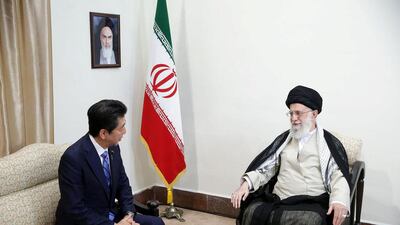Shuttle diplomacy with Iran is back on the international agenda, but missions such as the German foreign minister Heiko Maas's trip to Tehran last week only serve to underline the regime's chosen strategy of confrontation.
In every crisis, the choreography of diplomatic mediation provides essential clues to onlookers. After a fairly candid admission that Europe had few levers of respite to offer the Iranians, Mr Maas headed back to Berlin empty handed.
As he flew home, a telling tweet came from a relatively moderate face of the Iranian regime. The former nuclear negotiator Hossein Mousavian posted a picture of the missile range of Iran’s rocket and ballistic arsenal. The outer circle stretched as far as the heel of Italy and the south shore of Sri Lanka.
Yet the shuttle diplomacy continues. A technical team of European officials spent last week in Iran. A statement said the teams had “agreed a roadmap to expedite progress” towards alleviating economic pressure on the Iranian people.
Within days, Helga Schmid, the European Union's chief diplomat and an original architect of the Joint Comprehensive Plan of Action (JCPOA), embarks on her own mission travelling to the Gulf, including the UAE, and Tehran.
Darkening clouds form the backdrop to these exchanges. Iran has made no secret of its decision to become a more disruptive player, but the wider world has been slow to absorb the implications of this.
In the notorious tanker wars of the 1980s, about 30 vessels were struck. Already, six have been sabotaged in just a few weeks.
The images of burning Japanese and Norwegian ships in the Sea of Oman on Thursday demonstrate that tensions are on the rise. The head of the Arab League, Ahmed Aboul Gheit, has suggested Iranian involvement, while US secretary of state Mike Pompeo has blamed Tehran outright. UN secretary general Antonio Guterres has stated that an independent investigation is required to ascertain precisely who committed the attacks. Meanwhile, the presence of Iranian state television in a helicopter over the stricken craft certainly demonstrates that Tehran is keen to amplify the impact of these attacks.
A research note from the Centre for Strategic and International Studies has warned that Iran’s capabilities include drones, anti-ship missiles, submersibles and small craft, and that they cover a wide area. “Iran can use its naval, air, and/or missile forces and proxies to attack ships anywhere in the Gulf, around the Strait of Hormuz, in the Gulf of Oman and in Indian Ocean waters,” the paper said.
Shinzo Abe, Japanese prime minister, looking forlornly at an unopened letter from President Donald Trump that he had brought to Tehran on a peacemaking visit, only to be told by Supreme Leader Ayatollah Ali Khamenei that it was pointless to reply, was another revealing picture.
Tehran has been hit hard by the de facto demise of the 2015 nuclear agreement. Imposition of US sanctions has quickly starved Iran of cash revenues. For a regime prosecuting foreign conflicts across the region, via its proxies, this lack of resources has come as a quick and stinging blow.
It is important to note that Iran is using tools that were not covered by that deal. According to an in-depth report earlier this year from the Brookings Institution, Iran has long used the accumulation of missiles to promote regional influence and bolster the military capabilities of its proxies. The report points out that the missile force has been used for attacks on an increasingly regular basis.
It lists three goals for Tehran’s missile programme: to thwart US containment efforts, to overturn the Middle East power structure and ultimately to pursue “Persian greatness”.
These are existential ambitions that cannot be curtailed by compromise. The report sees a role for diplomacy, but only if Iran has a change of heart. More realistic containment options include tighter trade restrictions on missile technology, including interdiction of shipments on the high seas.
It recommends the US and allies adopt a more aggressive cyber-sabotage policy and the installation of anti-missile systems in threatened states, especially around airbases.
The US should also extend its declaration that Iran will pay a price for any strikes on US forces or its assets, and cover its allies under bombardment.
Dennis Ross, the former US Middle East envoy, predicted last week that the ship attacks would continue until a costly response from the US was feared.
An alternative trajectory, such as the one Ms Schmid may wish to pursue on her upcoming trip, doesn’t seem feasible. The European focus on the JCPOA has, in effect, become a convenient distraction.
The missile arsenal, the proxy campaigns and open threats of disruption to the oil trade are the meaningful challenges that Tehran is throwing down to the world.
Mr Trump has said that Iran is not ready for a deal and, in light of recent events, neither is Washington. In a recent interview with The Atlantic, Ash Carter, former defence secretary under Barack Obama, noted that while Mr Trump's team has only spoken of political and economic responses so far, but he would be preparing military options if he still held his old job. The seriousness of this situation is now undeniable.

